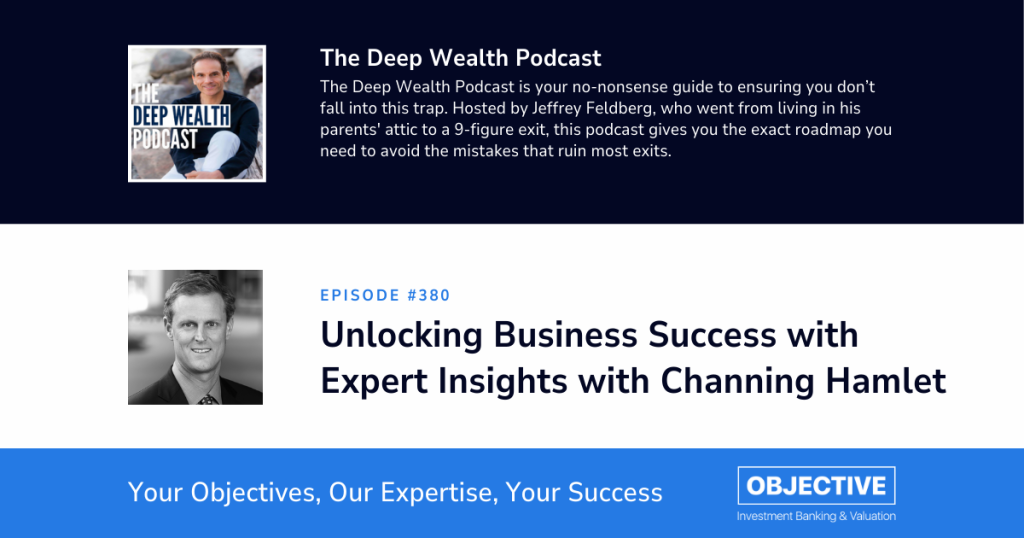Navigating the exit from your business is a big move, and it’s one that comes with plenty of options and considerations.
Here at ObjectiveIBV, we are a leading investment banking and valuation firm offering Sell-Side M&A and Valuation Advisory Services for middle market companies, and we’re here to shed light on the paths you can take when it’s time to transition out of your company.
Whether it’s a case of selling the business to retire, merging with another powerhouse to grow, or any of the other routes you might be contemplating, understanding the pros and cons of each exit strategy is crucial. Our goal is to provide you with the insights and clarity needed to make the best decision for your future and the legacy of your business.
Let’s dive into the common exit strategies and explore what each one might mean for you.
Why is an exit plan important?
Having a well-thought-out exit strategy is crucial. It’s not just about securing a financial future for yourself; it’s about preserving the value of the business you’ve worked so hard to build.
A clear exit plan helps you reduce or eliminate uncertainties, maximizing the value you get from the business when it’s time to step away. It also ensures that the legacy of your business, the jobs of your employees, and the trust of your customers are maintained or even enhanced during the transition.
Whether you’re looking to retire, start a new venture, or simply step back from day-to-day operations, understanding your exit options is the first step in safeguarding your investment and ensuring that your business continues to thrive, even in your absence.
Exit Strategy Options
The exit strategy you choose should reflect your personal and business goals, the unique nature of your enterprise, and the current market conditions. Each strategy has its nuances and implications, and understanding them is key to making the right choice. Let’s explore some of the common exit strategies:
Outright Sale
- Strategic Buyer: Selling to a strategic buyer who sees unique value in your business’s assets. This can maximize financial return, as seen in the acquisition of LinkedIn by Microsoft.
- Financial Buyer: Selling to financial buyers like private equity firms. This option can provide a swift exit if your business has strong cash flows and growth potential.
Transitioning Ownership
- Management Buyout (MBO) or Employee Stock Ownership Plan (ESOP): Handing ownership to your employees or management team. This requires building a strong, competent team and cultivating a culture of ownership, similar to the model used by Chobani.
- Family Succession: Passing the business to the next generation, as demonstrated by Walmart. This involves training the next generation of leaders and engaging family members early to ensure a smooth transition.
Altering Your Role
- Passive Ownership: Remaining involved in the business but stepping back from day-to-day operations, similar to Warren Buffet’s approach with Berkshire Hathaway. This involves delegating responsibilities to potential leaders within the company.
- Franchising: Expanding your business through a franchising model, similar to McDonald’s. This requires creating a replicable business manual and starting small to test the model’s success before extensive expansion.
The exit strategy that you choose depends heavily on your personal and financial objectives, the readiness of your business, and the state of the market. Now let’s dive into each option in more detail and go over the potential pros and cons of each.
Outright Sale – The Pros and Cons
Strategic Buyer
Pros:
- Higher Financial Return: Often willing to pay a premium for strategic benefits.
- Enhanced Market Position: Combines strengths for increased competitiveness.
- Synergies: Potential for cost savings and increased revenue through operational efficiencies.
Cons:
- Lengthy Process: Complex due diligence and negotiation stages.
- Loss of Control: Limited influence over the business’s future direction post-sale.
- Cultural Differences: Potential for clashes between merging organizational cultures.
Financial Buyer
Pros:
- Quick Exit: Generally faster and simpler transaction process.
- Capital for Growth: Financial buyers can inject capital to fuel further expansion.
- Potential for Future Involvement: Possibility to retain a minority stake or advisory role.
Cons:
- Potentially Lower Return: May offer less than strategic buyers due to focus on financial returns.
- Focus on Financial Performance: Can overlook cultural and operational aspects of the business.
Transitioning Ownership
Management Buyout (MBO) or Employee Stock Ownership Plan (ESOP)
Pros:
- Maintains Business Continuity: Preserves company culture and operational knowledge.
- Motivates Employees: Increases employee loyalty and motivation through ownership.
- Smoother Transition: Often a smoother transition as current management knows the business well.
Cons:
- Requires Strong Management Team: Needs a capable and prepared management team.
- Complex Financing: Can involve complicated financing arrangements.
- Potential Conflicts: Possible internal conflicts over new ownership structure.
Family Succession
Pros:
- Preserves Family Legacy: Maintains the business within the family, preserving values and culture.
- Continuity: Ensures continuity and stability in leadership.
- Trusted Successors: Successors are often deeply committed to the business.
Cons:
- Preparation Required: Requires grooming the next generation of leaders early.
- Potential Family Conflicts: Can lead to family disputes and conflicts.
- Lack of Interest: Successors may lack interest or capability to run the business effectively.
Altering Your Role
Passive Ownership
Pros:
- Retains Ownership Benefits: Continues to receive financial benefits from the business.
- Focus on Strategic Direction: Allows focus on long-term strategy rather than daily operations.
- Leadership Continuity: Can appoint competent leaders to manage operations.
Cons:
- Requires Strong Leaders: Needs reliable and capable management to handle day-to-day activities.
- Potential Loss of Control: Less influence over daily operational decisions.
- Delegation Challenges: Finding the right leaders and effectively delegating responsibilities can be difficult.
Franchising
Pros:
- Rapid Expansion: Facilitates quick growth with lower capital investment.
- Local Market Knowledge: Franchisees bring valuable local market insights.
- Scalable Model: Creates a scalable and replicable business model.
Cons:
- Complex to Implement: Requires a well-documented and replicable business process.
- Potential Loss of Control: Franchises may operate differently from the original business.
- Quality Control: Maintaining consistent quality across franchises can be challenging.
Key Takeaways
- Choosing the right exit strategy depends on your personal and financial goals, the readiness of your business, and current market conditions.
- Strategic buyers and financial buyers offer different advantages and challenges in an outright sale.
- Transitioning ownership to management or family requires careful planning and preparation to ensure a smooth transition.
- Altering your role through passive ownership or franchising can provide continued benefits while reducing direct involvement.
Planning your exit strategy should start years before your intended exit. Early and thorough preparation can significantly enhance the rewards from your entrepreneurial journey. Always consult with trusted advisors to ensure the best possible outcome.
If you’re considering an exit strategy and want to discuss which option is best for you or get an accurate understanding of the current value of your business, reach out to us for a consultation. We are here to help you navigate this critical phase with expertise and personalized advice.
Disclosure
The above testimonials may not be representative of the experience of other customers and past performance is not a guarantee of future performance or success.
This news release is for informational purposes only and does not constitute an offer, invitation or recommendation to buy, sell, subscribe for or issue any securities. While the information provided herein is believed to be accurate and reliable, Objective Capital Partners and BA Securities, LLC make no representations or warranties, expressed or implied, as to the accuracy or completeness of such information. All information contained herein is preliminary, limited and subject to completion, correction or amendment. It should not be construed as investment, legal, or tax advice and may not be reproduced or distributed to any person. Securities and investment banking services are offered through BA Securities, LLCMember FINRA, SIPC. Principals of Objective Capital are Registered Representatives of BA Securities. Objective Capital Partners and BA Securities are separate and unaffiliated entities.









